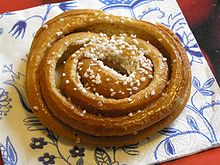Nib sugar


Nib sugar (also pearl sugar and hail sugar) is a product of refined white sugar. The sugar is very coarse, hard, opaque white, and does not melt at temperatures typically used for baking. The product usually is made by crushing blocks of white sugar, then sifting to obtain fragments of a given diameter. The sugar may also be made in an extrusion process.
It is known as pärlsocker (pearl sugar) in Sweden, and as perlesukker in other Scandinavian countries, except for in Finland, where it is called helmisokeri (also pearl sugar) or more commonly raesokeri ("hailstone sugar").
In Scandinavia, pärlsocker is used extensively to decorate various pastries and confections, cookies, especially on top of plain Swedish bulle or Finnish pulla [1] cakes, muffins[2] and buns, such as kanelbullar (cinnamon buns) and chokladbollar.
In Germany it is known as Hagelzucker and traditionally used on Christmas cookies and cinnamon buns.
In Belgium, it is used in Liège waffles, while in Friesland it is used in sûkerbôle[3] (sugar bread).
